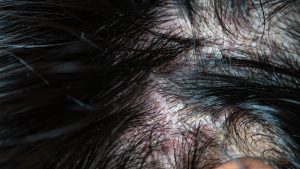Lichen planopilaris (LPP) is a rare, chronic, and progressive form of scarring hair loss that can affect both men and women of all ages. It belongs to a group of hair loss disorders called cicatricial alopecia, which means that hair follicles are damaged and replaced by scar tissue.
The exact cause of LPP is unknown, but it is believed to be an autoimmune disorder, in which the body’s immune system mistakenly attacks hair follicles. The word “lichen” in Lichen planopilaris refers to the characteristic rash that often accompanies the hair loss.

LPP typically presents as small, flat, shiny, reddish-purple bumps on the scalp, which may be itchy or painful. The rash can also occur on other parts of the body, such as the arms, legs, and trunk, but the scalp is the most commonly affected area. The hair loss in LPP usually begins at the crown of the scalp and spreads outwards, leading to patchy hair loss and eventually complete baldness in the affected area.
The pathology of LPP involves inflammation and destruction of hair follicles. In the early stages of the disease, the hair follicles become inflamed, which can cause itching, burning, or tenderness on the scalp. As the inflammation persists, the hair follicles are gradually destroyed and replaced by scar tissue. Scar tissue is a fibrous, non-elastic tissue that cannot support the growth of hair follicles, leading to permanent hair loss in the affected area.
The diagnosis of LPP is made based on the clinical presentation and a scalp biopsy. A scalp biopsy involves removing a small piece of skin from the affected area of the scalp and examining it under a microscope to confirm the presence of inflammation and scarring. Blood tests may also be ordered to rule out other autoimmune diseases that can cause hair loss, such as lupus or dermatomyositis.
There is currently no cure for LPP, and the goal of treatment is to slow down or stop the progression of the disease and manage symptoms. Treatment options for LPP include topical and oral medications, corticosteroid injections, and hair transplantation. Topical medications, such as corticosteroid creams or ointments, can help reduce inflammation and itching on the scalp. Oral medications, such as hydroxychloroquine or mycophenolate mofetil, can help suppress the immune system and reduce inflammation in the hair follicles. Corticosteroid injections directly into the affected area of the scalp can help reduce inflammation and promote hair regrowth. Hair transplantation may be an option for patients with stable disease who have areas of permanent hair loss.
In conclusion, Lichen planopilaris is a rare hair loss disorder that can cause permanent baldness in the affected area. The pathology of LPP involves inflammation and scarring of hair follicles, which leads to the destruction of hair follicles and replacement by scar tissue. There is currently no cure for LPP, but treatment options are available to manage symptoms and slow down or stop the progression of the disease. It is important for patients with LPP to work closely with their healthcare provider to develop an individualized treatment plan and receive regular follow-up care.



